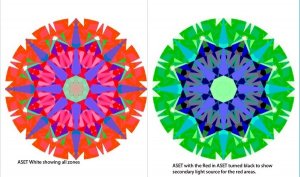Hello PS Trade Members and Prosumers! I would be very grateful if you could answer the questions I have below regarding the versatility of an ASET scope. I am wondering if it can an all-in-one device if used properly.
1. If the interior cone of an ASET scope is covered with pink/red paper, will it show the same results as an IdealScope, except that light obstruction will be shown as blue instead of black?
2. Please correct me if I am wrong: An ASET shows strong light return as red (equivalent to brighter/darker red in IS image) and weak light return as green (equivalent to less intense red/pink in IS image). Head obstruction will be blue for ASET and black for IS. Leakage is white in both ASET and IS images. If this is the case, why is an IdealScope always recommended in addition to an ASET? Wouldn't an ASET suffice to test a stone's light performance because it shows the same thing, but using more colors?
3. Can an ASET and IS show a stone's symmetry if the gemstone is centered within the cone? If not, what makes a H&A viewer so different?
4. An ASET should be used on all shapes/cuts, but are IdealScopes and H&A scopes to be used only for modern round brilliant diamonds (e.g., there are H&A squares like Brellia)? Why?
5. Is it impossible to have an intense/vivid colored diamond that also has excellent light performance? I never see light performance tools used for colored diamonds and other gemstones.
Thanks so, so much to all who reply!
1. If the interior cone of an ASET scope is covered with pink/red paper, will it show the same results as an IdealScope, except that light obstruction will be shown as blue instead of black?
2. Please correct me if I am wrong: An ASET shows strong light return as red (equivalent to brighter/darker red in IS image) and weak light return as green (equivalent to less intense red/pink in IS image). Head obstruction will be blue for ASET and black for IS. Leakage is white in both ASET and IS images. If this is the case, why is an IdealScope always recommended in addition to an ASET? Wouldn't an ASET suffice to test a stone's light performance because it shows the same thing, but using more colors?
3. Can an ASET and IS show a stone's symmetry if the gemstone is centered within the cone? If not, what makes a H&A viewer so different?
4. An ASET should be used on all shapes/cuts, but are IdealScopes and H&A scopes to be used only for modern round brilliant diamonds (e.g., there are H&A squares like Brellia)? Why?
5. Is it impossible to have an intense/vivid colored diamond that also has excellent light performance? I never see light performance tools used for colored diamonds and other gemstones.
Thanks so, so much to all who reply!








300x240.png)